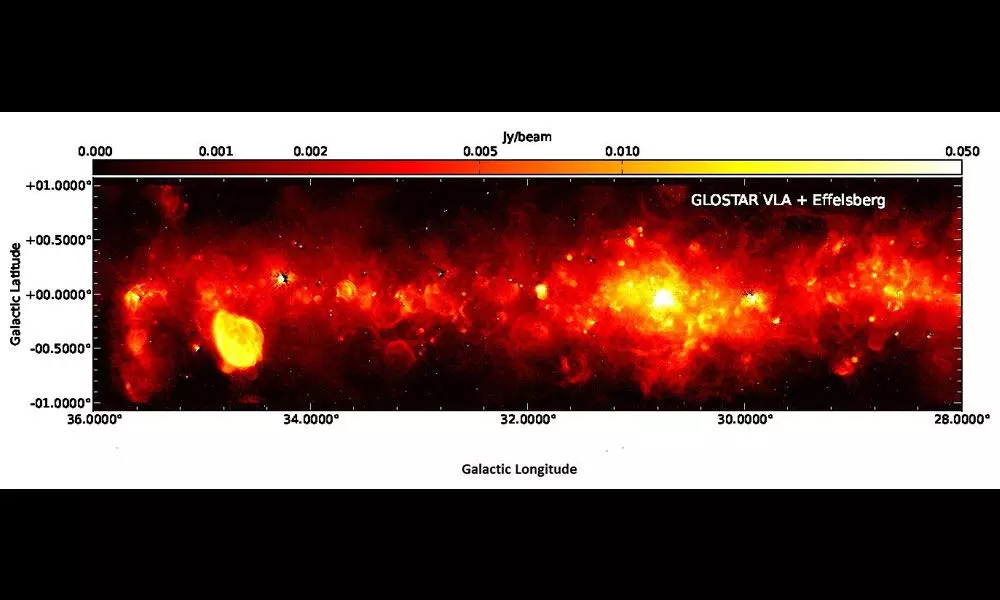Study offers new insights into star formation in Milky Way

Study offers new insights into star formation in Milky Way
An international team of astronomers has carried out an extensive new survey of the Milky Way revealing previously unseen signatures with unprecedented sensitivity and details that hint at how stars form and die, complex processes that have fascinated researchers for centuries.
Bengaluru: An international team of astronomers has carried out an extensive new survey of the Milky Way revealing previously unseen signatures with unprecedented sensitivity and details that hint at how stars form and die, complex processes that have fascinated researchers for centuries. The results were published in a series of papers in Astronomy & Astrophysics by the team, which includes scientists from the Indian Institute of Science (IISc) and the Indian Institute of Space Science and Technology (IIST).
The data for the survey, which spanned a large part of the Milky Way, was gathered using two powerful radio telescopes: the Karl G Jansky Very Large Array (VLA) at the National Radio Astronomy Observatory (NRAO), USA, and the Effelsberg 100-m radio telescope operated by the Max Planck Institute for Radio Astronomy (MPIfR), Germany, as part of the GLOSTAR (Global View on Star formation in the Milky Way) project.
Nirupam Roy, Assistant Professor at the Department of Physics, and Rohit Dokara, his former undergraduate student from IISc, as well as Jagadheep D Pandian, Associate Professor at the Department of Earth and Space Sciences, IIST, are among the Indian scientists who are part of the GLOSTAR project.
Dokara, now a PhD student at MPIfR, is the first author on one of the papers that reports the detection of new supernova remnants (SNRs) – structures born from the explosive death of massive stars – in our galaxy.
Previous surveys have detected only about one-third of the expected number of SNRs in the Milky Way (which is nearly 1000). The GLOSTAR team has now discovered 80 new SNR candidates in the VLA data alone, with more expected to be identified from the combined Effelsberg and VLA data. They were also able to confirm the presence of 77 previously discovered SNR candidates and reclassify a few that were misidentified. This is impressive considering that the northern telescopes utilised by GLOSTAR are able to see only half of the inner regions of the Milky Way. "This is an important step to solve this long-standing mystery of the missing supernova remnants," says Dokara.
The researchers, according to the IISc release, were also able to detect other traces of star formation. One of them, for example, is radio emission from methanol molecules in a nearby large star-forming complex called Cygnus X. These are typically emitted from massive stars in very early stages of formation. The team was also able to detect dense pockets of ionised hydrogen, another tell-tale sign of the presence of massive young stars.
Young stars are usually surrounded by thick clouds of dust and gas. "Because visible light gets absorbed in this dense cloud around stars, most of the optical telescopes don't reveal much. What people look for, instead, are radio emissions," explains Roy, who has previously worked at both NRAO and MPIfR.
"Since the GLOSTAR survey detects a wide range of radio emission such as that from methanol molecules to ionised hydrogen, it is able to probe the formation of massive stars from very early to relatively late stages, which is important to get a complete picture of star formation in the Milky Way," adds Pandian, who has also previously worked at MPIfR.
The Effelsberg radio telescope is a single large dish spanning 100 m in diameter, capable of detecting large-scale structures, whereas the VLA is a collection of small antennas which work together as an interferometer to capture the details at high resolution. The data pooled from both telescopes helped the researchers paint a more comprehensive picture of different astrophysical objects in the region. "This clearly demonstrates that the Effelsberg telescope is still very crucial, even after 50 years of operation," says Andreas Brunthaler of MPIfR, project leader and first author of the survey's overview paper. Karl Menten, the Director of MPIfR who initiated GLOSTAR, adds, "It's great to see the beautiful science resulting from two of our favourite radio telescopes joining forces." Both Pandian and Roy currently maintain Max Planck-India Partner Groups with Menten to continue the close collaboration and, in particular, to expand the scope of the GLOSTAR project.
Other members of the research team include scientists from MPIfR and NRAO, and collaborators from institutions in the UK, South Africa, Mexico, France and Australia. With observations and analysis ongoing, more results are expected to be published over time.














